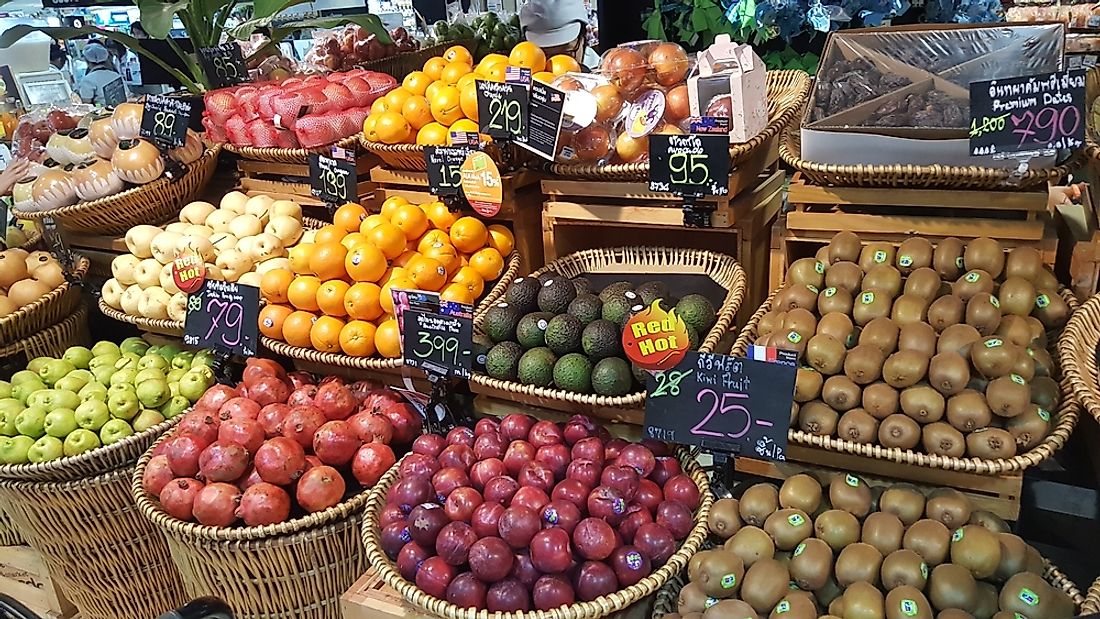Countries Who Import the Most Food Relative to Merchandise Imports

Food Security
Food is one of the basic necessities for life, particularly such staples as wheat, rice, and corn. Some countries are lucky enough to be able to produce sufficient amounts of agriculture so as to feed their populations and export the excess. However, other nations are unable to produce enough food to meet their needs. This lack of food production happens for many reasons, including a lack of agricultural technology, having a non-conducive climate for growing crops, or a large or growing population. When food cannot be produced domestically, the government must import. Governments that import large percentages of food relative to total imports put their residents at risk of food insecurity. This is particularly true when they rely on just one or two suppliers. Food security is when all the people of a region have enough food to sustain a healthy life.
Food Power
When one country is responsible for the majority of the global supply for a crop, or when a major food importer relies on just a few suppliers, what happens when that country stops producing? Production could be halted by drought, changing temperatures, or even war. Food itself can even be used as a weapon when the supplier country withholds the commodities from importers in order to coerce behavior. This act is referred to as food power. When a food commodity suddenly becomes unavailable for any reason, its cost rises. Countries that rely on food imports, largely developing countries, are then unable to afford the imports. A situation such as this can be dangerous for the health of the population. Below is a look at the countries with the highest percentage of food as part of its total imports.
Countries with High Relative Food Imports
Of all of the imports to Cape Verde, 32% are comprised by foodstuffs. The country imports 63% of its concentrated milk from Belgium-Luxembourg, 34% of its poultry from the Netherlands, and 61% of its rice from Thailand.
Antigua and Barbuda is also relatively reliant on food imports, and they make up 27% of the country’s total imports. This island nation is a relatively small importer on a global scale, the value of its total imports reaches $735 million. The majority of its food expenditure is on foodstuff, particularly flavored water from the United States but it also has a significant agricultural and animal product imports. It imports 70% of its poultry from the US and 72% of its wheat flour from Saint Vincent and the Grenadines.
The third largest percentage of food imports is found in Mauritius. Of this country’s total imports, 22% is food. Mauritius is a big importer of frozen fish which makes up 4.8% of its total animal product and by-product imports. Nearly half, 45% of this comes from Spain. Additionally, the country imports large amounts of rice, of which 84% comes from India.
Other countries with a significant dependence on food imports can be seen in the table appended below.
What Factors Increase Vulnerability to Food Insecurity?
As previously mentioned, countries that rely on large amounts of food imports to meet their respective populations' needs are often left in vulnerable positions. As their populations continue to grow, so too will their requirement for imports of such essentials. They are one natural disaster away from a price leap that could leave them in a food crisis particularly when a vast majority of one commodity comes from just one supplier. Governments in this situation would be wise to invest in domestic agriculture in order to strengthen the infrastructure and promote increased food production. They should work to conserve arable farmland and freshwater resources as well to avoid food crisis.
Countries With The Most Food Imports Relative To All Merchandise Imports
| Rank | Country | Food Imports Relative to All Merchandise Imports |
|---|---|---|
| 1 | Cape Verde | 32% |
| 2 | Antigua and Barbuda | 27% |
| 3 | Mauritius | 22% |
| 4 | Barbados | 21% |
| 5 | Bermuda | 21% |
| 6 | Cyprus | 20% |
| 7 | Armenia | 20% |
| 8 | Nepal | 18% |
| 9 | Bosnia and Herzegovina | 18% |
| 10 | El Salvador | 17% |











